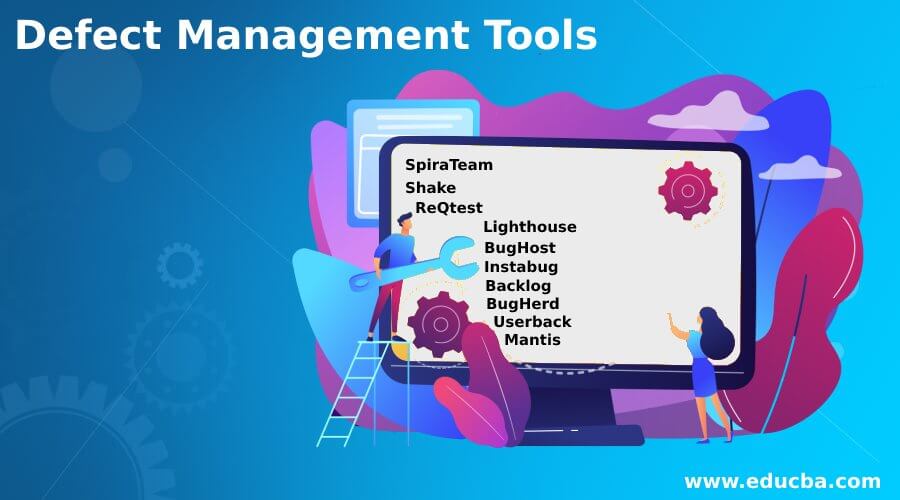Updated June 14, 2023

Introduction to Defect Management Tools
The following article provides an outline for Defect Management Tools. However, we would raise some questions before considering the popular list of defect-tracking tools. First, are you employing Excel sheets to track defects at a company? We don’t say Excel is not a good way to track bugs, but why can’t we try to have problem-tracking tools when we’ve got the best open-source alternative tools? Second, an organization has everything to do with ROI (return on investment). Therefore, most start-ups do not invest in tools for defect tracking and use excellent sheets to move forward.
Various Defect Management Tools
Given below are the various defect management tools; some of them are paid, and some of them are free:
1. SpiraTeam
The SpiraTeam is a fully built-in bug tracking solution, turn key Application Lifecycle Management (ALM). With integrated traceability, SpiraTeam allows you to manage the entire testing process, from testing requirements to bugs and problems. SpiraTeam provides the following features.
2. Shake
Shake SDK is software for bug reporting that allows you to monitor and track incoming bug reports. Users can prioritize, assign and add tags to a report once a bug is reported. Shake also offers rich information on every bug report, including the activity history, device information, and detailed reproduction steps. These can be searched, so a user can easily find them.
3. ReQtest
ReQtest provides a bug-tracking module that lets developers and testers work together to fix bugs easily. You can import all bug reports from a CSV file with ReQtest. You can sync ReQtest bugs with Jira problems automatically. In addition, JIRA projects can be easily integrated into ReQtest projects.
4. Lighthouse
Lighthouse is an application for web-based problem tracking. Whether you’re a large business or a small, bootstrapped team, Lighthouse is the ideal solution to track your projects easily. It also includes many useful services such as Airbrake, Exceptional, Github, Beanstalk, etc.
5. BugHost
BugHost is a fully functional bug tracker for companies and SMEs that need a large volume license at a reasonable price. Categorization and delegation of bugs and reports can be done easily and efficiently. It offers a window-designed end-to-end solution. It enables unlimited defects to be recorded. Even your clients can post bugs directly to your project with strong bug access security.
6. Instabug
Instabug is a mobile application bug-reporting tool. It enables mobile teams to confidently release bug and crash reports, in-app surveys, and user feedback. To provide your users and test users with an easy way to share feedback and report any bugs they find in your application, you can connect Jira to Instabug.
7. Backlog
A backlog is a software designed for development teams for online bug tracking and project management. Everyone has a history of updates, comments, and status changes to report bugs. It’s easy. Search and filter problems are easy to find. It is also commonly used to manage IT projects with features including subtasks, Kanban-style boards, Gantt and burndown charts, Git and SVN repositories, wiki, IP access controls, and tracking bugs. Android and iOS indigenous applications are a plus.
8. BugHerd
BugHerd makes tracking bugs and collecting and managing feedback on web pages the easiest way. For accurate identification, your team and customers will provide feedback on the elements of a web page. BugHerd collects data you need to replicate and fix bugs quickly, like the browser, CSS selector data, OS, and even a screenshot. The Kanban Task Board, where bugs can be assigned and handled, receives bugs, feedback, and technical information. BugHerd can also integrate with your existing project management tools, so your team keeps your bug resolution on the same page.
9. Userback
Userback is a bug reporting tool that makes it easy to report bugs with annotated and video screenshots. It helps developers solve problems much faster with all information by automatically collecting console logs, browsers, and information on the operating system. The feedback widget can easily connect to any website, enabling users to report bugs without leaving your website.
10. JIRA
Through its easy-to-use framework, thousands of software professionals use JIRA as a bug-tracking tool. JIRA is a commercial product that helps track and organize team problems and prioritize and update them with the project. It is a tool that integrates directly with code development and makes it ideal for developers. It is not restricted to the software industry only because of its ability to track any problem. It supports agile projects. It comes with many add-ons, which increase the power of this tool over other instruments.
11. Mantis
This tool can be easy to use if you have used another bug-tracking tool. Mantis has its mobile version and comes as a web app. It integrates with various databases, including PostgreSQL, MySQL, and MS SQL, and offers integration with chat, time tracking, wiki, RSS, and other functionalities.
Conclusion
In this article, we have seen various defect management tools to find defects in data so you can develop a system or program without any hassle. You can choose any of them based on your requirements.
Recommended Articles
This is a guide to Defect Management Tools. Here we discuss the introduction and the various defect management tools, respectively. You may also have a look at the following articles to learn more –
